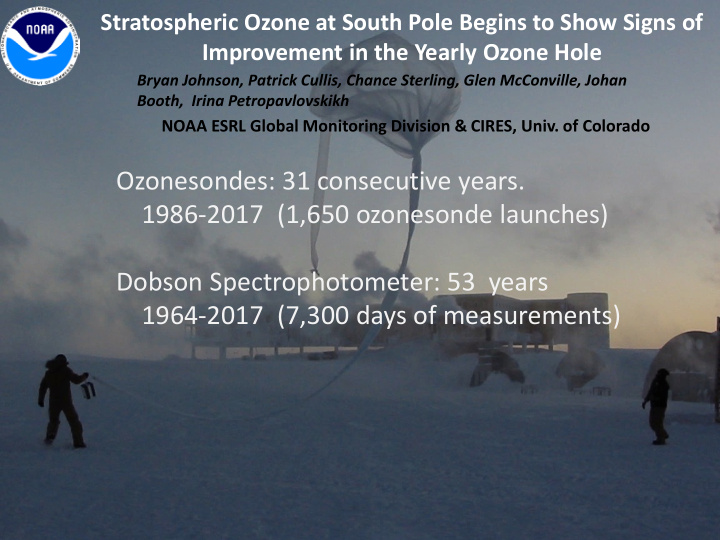



Stratospheric Ozone at South Pole Begins to Show Signs of Improvement in the Yearly Ozone Hole Bryan Johnson, Patrick Cullis, Chance Sterling, Glen McConville, Johan Booth, Irina Petropavlovskikh NOAA ESRL Global Monitoring Division & CIRES, Univ. of Colorado Ozonesondes: 31 consecutive years. 1986-2017 (1,650 ozonesonde launches) Dobson Spectrophotometer: 53 years 1964-2017 (7,300 days of measurements)
Outline Stratospheric Ozone Measurements, Trends, Recovery. 1. Ozonesondes: Total Column Ozone 14-21 km Layer Column Ozone September Ozone Loss Rate 2. Dobson Spectrophotometer: Total Column Ozone 3. Satellites: Total Column Ozone Area of Ozone Hole Photo by Christian Krueger, IceCube
Stratospheric Ozone Measurements Total Column Ozone (Dobson Units) Sun Satellite 30 km Ozonesonde Dobson Spectrophotometer illustration by Patrick Cullis Antarctica Typical Range = 260-360 DU Ozone Hole Defined Threshold = 220 DU Ozone Hole Minimum = 85-90 DU
Stratospheric Ozone Measurements Total Column Ozone (Dobson Units) Sun Satellite 30 km Ozonesonde Dobson Spectrophotometer illustration by Patrick Cullis 2016 Antarctica Typical Range = 260-360 DU Ozone Hole Defined Threshold = 220 DU Ozone Hole Minimum = 85-90 DU NASA Goddard Image: October 1, 2016 114 Dobson Units
Stratospheric ozone severity & recovery depends on: chlorine (chemistry) temperature & meteorological conditions. 1. Ozonesondes: The NOAA Ozone Depleting Total Column Ozone Gas Index: Guiding Recovery of the Ozone 14-21 km Layer Column Ozone Layer. Montzka, et al. September Ozone Loss Rate 2. Dobson Spectrophotometer: Total Column Ozone chlorine (chemistry) temperature & meteorological conditions. Total Ozone Column Change (%) 3. Satellites: Total Column Ozone Area of Ozone Hole WMO Scientific Assessment of Ozone Depletion:2014 Photo by Christian Krueger, IceCube
Stratospheric ozone severity & recovery depends on: chlorine (chemistry) temperature & meteorological conditions. 1. Ozonesondes: The NOAA Ozone Depleting Total Column Ozone Gas Index: Guiding Recovery of the Ozone 14-21 km Layer Column Ozone Layer. Montzka, et al. September Ozone Loss Rate Antarctica ozone layer recovery publications: 2. Dobson Spectrophotometer: 2011: Hassler, et al. An assessment of changing ozone loss rates at Total Column Ozone South Pole: 25 years of ozonesonde chlorine (chemistry) measurements (JGR). temperature & meteorological conditions. Total Ozone Column Change (%) 2016 : Solomon, et al. Emergence of 3. Satellites: healing in the Antarctic ozone layer Total Column Ozone (Nature). Area of Ozone Hole WMO Scientific Assessment of Ozone Depletion:2014 Photo by Christian Krueger, IceCube
Pinatubo aerosol in 10-14 km
Sudden stratospheric warming
Record Low = 93 DU
Ozonesonde Profiles from selected years: 1993 – Pinatubo aerosol 2002 – Sudden stratospheric warming 2006 – Record low ozone hole 2015 – longest stable vortex 2016 – most recent
1993 2002 2015 2006
1993 2002 September sudden Pinatubo volcanic stratospheric warming aerosol 14 -21 km 2015 2006 Latest vortex breakup Record Low 16 th lowest / 31 years Satellite – largest area
1993 2002 September sudden Pinatubo volcanic stratospheric warming aerosol 14 -21 km 2015 2006 Latest vortex breakup Record Low 16 th lowest / 31 years Satellite – largest area
1993 2002 September sudden Pinatubo volcanic stratospheric warming aerosol 14 -21 km 2016 2006 Average ozone hole Record Low min 15 th lowest / 31 years Satellite – largest area
South Pole Ozonesondes Ozonesonde Median: 1990-2014
South Pole 14-21 km Layer: September Depletion Rate Slope = 3.0 DU/Day
Summary Charts and Table Dobson Units September Depletion Rate (14-21 km)
SUMMARY The previous 3 summary charts indicate improvement, but next several • years of ozonesonde data will help smooth out the year- to-year variability in ozone due to stratospheric temperature and meteorological conditions. 2010-2016 (last 7 years) shows improvement over 1990-1999 and • 2000-2009 decades. 20-24 km ozone layer shows significant improvement. Indicator for recovery predicted by Hofmann (1997).
early October South Pole Station: Located in the middle of the polar vortex and springtime ozone depletion area.
E lectrochemical C oncentration C ell ozonesonde
Recommend
More recommend